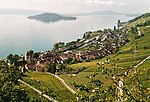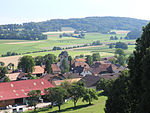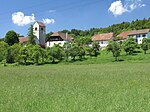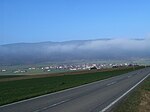St. Peter's Island (French: Île Saint-Pierre; German: Sankt Petersinsel) is a peninsula and former island situated in Lake Biel in the canton of Bern, Switzerland. It has a length of about 5 kilometres (3.1 mi) and a maximum width of 800 metres (2,600 ft). Its highest point is 474 metres (1,555 ft) above sea level or 45 metres (148 ft) above lake level (429 m [ 1,407 ft ]). It was formed in the last Ice Age (see Pleistocene), when the Rhône Glacier reached as far as the Jura mountains. It is a promontory of the Jolimont, above Erlach. Politically the island is split between the municipalities of Erlach and Twann-Tüscherz, the largest part belonging to the latter municipality.
In the late nineteenth century, following the engineering works of the Jura water correction, the water-level of the three lakes of the Seeland have dropped enough to clear the until-then hidden isthmus, linking Cerlier to St. Peter's Island, which has ever since become a peninsula, although separated from the shore by a canal.
Monks of the Cluniac order were the first inhabitants of the island, and built a monastery here in 1127.
Before his expulsion, Jean-Jacques Rousseau spent two months on the island in 1765, calling it the "happiest time of his life".










